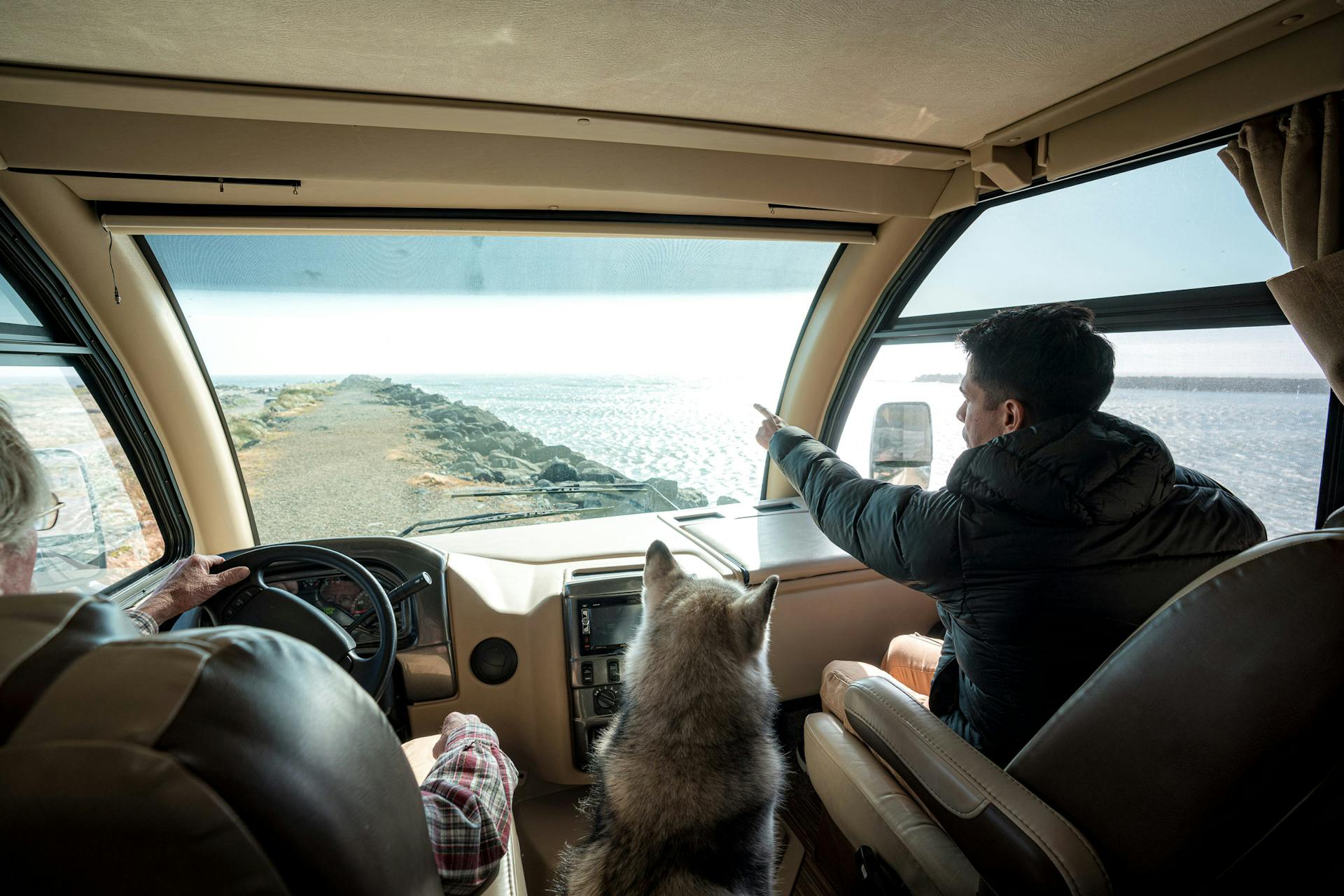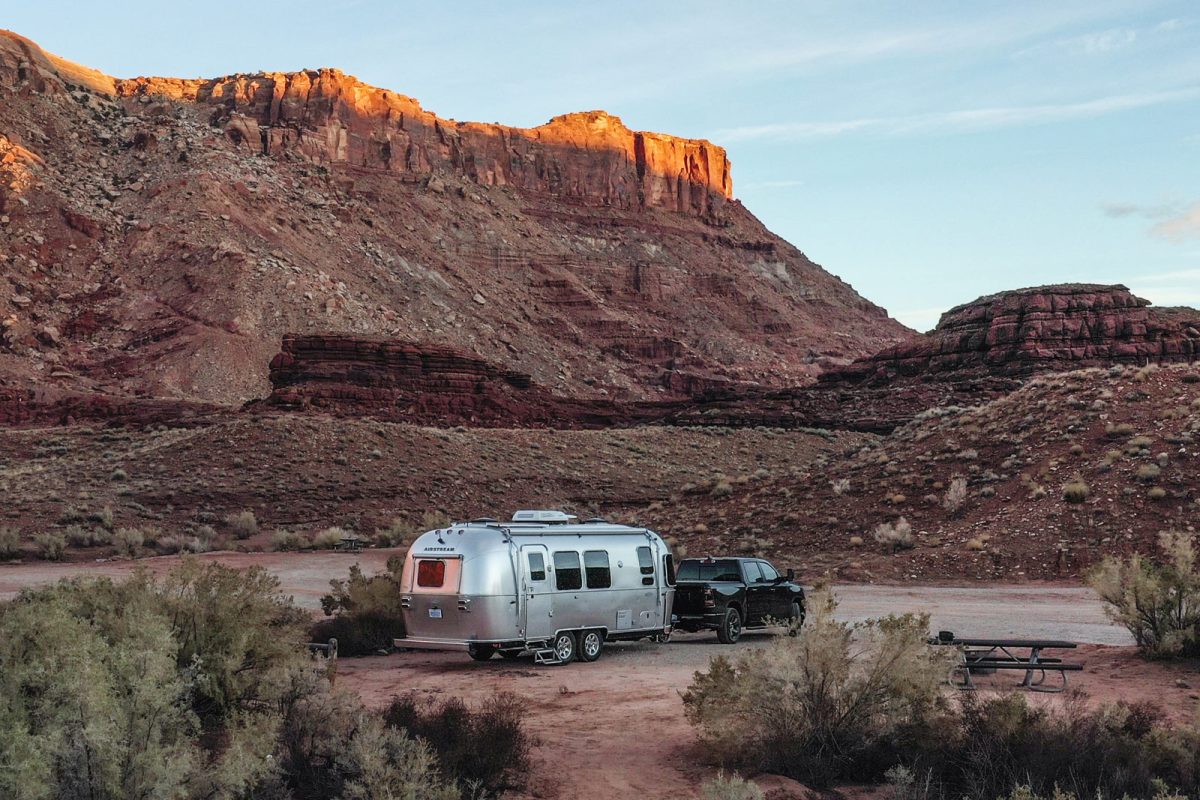How to Drive an RV Like a Pro

This blog post was contributed by Fiorella Yriberry, an experienced RVer and writer for RVshare.com.
You’re ready to hit the road—you rented your RV with RVshare, you stayed up watching all sorts of videos on #rvlife and how to drive an RV, you booked all your campsites with Campspot, and you can’t wait to get your adventure started. You show up to pick up the RV, they hand over the keys, and suddenly your entire world freezes.
“How am I supposed to actually drive this thing?”
Let me start by saying, you are not alone. That was exactly my experience the first time I showed up to drive what would become our full-time home. After all, the videos and pictures never do the size of these rigs justice.
After a few years on the road with no accidents to report and over 25,000 miles covered, I am happy to help you learn how to drive an RV like a PRO! We will cover all of the important tips, tricks, and reminders to get you safely and confidently out on the road.
Let’s get started.
RV Driving School 101

These starting tips might seem like common sense—and to be honest, some of them are—but you are here to be prepared, which means covering all the bases. Now, there is a big difference between driving an RV and pulling one (like a fifth wheel or travel trailer) which we will discuss later, but let’s start by covering some basic points that apply to both situations.
Practice, Practice, Practice
No matter how many times you read this article or any other “how to” blog post, nothing will beat your nerves more than simply practicing. Start in a flat and empty parking lot and simply drive around. What should you be practicing or considering? Let’s cover all of the important points:
1. Set Up Your Mirrors
Before starting any sort of driving practice, stop to adjust your mirrors. Bigger vehicles like RVs usually have more than just one mirror, so taking time to get familiar with them and adjusting them to your preference will make a huge difference on the road. You’ll want the two main mirrors to be straight out, watching for the lanes (just like the ones in your car). The two small bottom or often bubble-like mirrors should face out and down (these should show you the lines on the lane and the rear edge of the vehicle).
2. Practice Turning
Practice is key to learn how to make turns in a RV. A wider wheel base means wider turns. You’ll want to practice both sharp and regular 90-degree turns to find your RV’s turning radius. Going slow is going to be the most effective tip for your first (and all) turns. Another key element to note is your tailsweep, meaning you have to consider the extra length from the rear wheel to the bumper. In simple terms, don’t take sharp turns too early.
3. Get Familiar With Your Backup Camera
Backup cameras are extra helpful when driving an RV, so this is an important step in your “get ready to drive” to-do list. You’ll want to analyze the imagery of the camera in relation to distance in real life. So, back up slowly using the camera and then get out to get a real visual of what you did.
4. Understand Your Blind Spots
During your practice rounds, make it a point to understand what parts of the surrounding lanes are not visible to you, as making note of your blind spots will be a small but important piece of information that will help you make smarter and safer decisions once you are on the road.
5. Test the Brakes
A big difference between your car and an RV is the weight of the vehicles. You cannot slam on your brakes in your RV without asking for some sort of trouble. You want to start breaking well in advance by lightly pressing on the brakes. Getting in the flow with your RV brakes takes practice, so try out different scenarios in the safety of your practice rounds, like having to brake quickly.
6. Find Your Speed
RVs are slow cars and fast homes, which means you can take your home anywhere, but at about 65 miles per hour. Can you drive faster than that? Absolutely. Should you? I don’t think so. Why? Because you can’t brake as quickly as you can in a vehicle, meaning the faster you go, the more likely you’ll have to slam on the brakes. Also, your engine will perform better both while driving and in the miles-per-gallon category if you stay within the 55 to 60 miles-per-hour speed.
7. Know Your Numbers
After your practice rounds and before you hit the road, you’ll want to make sure you get familiar with your RV numbers, including how much gas you have, the distance you will travel, and (more importantly) the height of your RV. You don’t want to find yourself in front of a low bridge unsure about whether you will make it or not. Accurately measure your vehicle height before heading out.
Driving an RV

If your rental or new RV is driveable (rather than towable) like a Class A, B, or C, you will find that the information we covered above will set you up with almost everything you need to know before turning the ignition. But before you do, let me highlight some specific areas to consider for these rigs.
- If you are driving a diesel RV, like many out in the market, you’ll want to start the engine and let it warm up for at least 90 seconds before taking off. This is key to ensuring the best engine performance.
- Don’t underestimate your tailsweep, especially when driving Class A motorhomes. It’s always a better idea to take slow, wide turns than sharp ones. Consider this even more important when pulling in and out of small parking lots.
Towing an RV

Although we could certainly write a whole book on how to drive and tow an RV, we didn’t want to leave you without at least covering the basics.
Confirm Tow Capacity and RV Trailer Weight
Your vehicle’s towing capacity will help you determine the size of the RV that you can safely tow. To find your own vehicle ratings, check the frame of your driver door. Staying within your vehicle towing capacity assures that your vehicle will have no problem towing your RV.
Learn How to Hitch your Trailer
This is a vital step in getting ready to drive. Because the hitching and unhitching process is so specific to your make and model, we recommend you search for a specific “how to” guide before doing it for the first time.
Pro Tip: Schedule in the extra time to go over the hitching and unhitching process when you are picking up your RV rental!
If you’ve never towed before, you’ll want to make sure you start with some practice rounds, especially when it comes to reversing and making turns. And remember, slowing down always helps! The truth is, driving like a PRO comes from practicing and education. Don’t be afraid to ask for help and seek out additional resources if needed. It’s always better to be over-prepared!
Keep Practicing!

As for me, it took three days with lots of parking lot practice hours and small drives to let go of the nerves and get a grip on how to feel confident behind the wheel. So, when it comes to learning how to drive an RV—just practice!
See you out on the road!
Fiorella Yriberry is a Bolivian-born and raised nomad content creator and tiny home dweller. Her journey started in 2018 when she moved in full time to a self-converted home on wheels named “Luna,” leaving her 9-to-5 hospitality career for a simple, slow life down the wild unpaved roads of the USA. Fiorella started creating photography/film content for her social media channels in 2020 and written content for RVshare since early 2022. You can find her adventures in any social media channel under @growingslowandwild or by visiting www.growingslowandwild.com
Image credit: RVshare